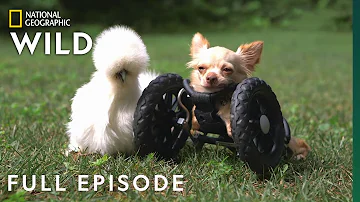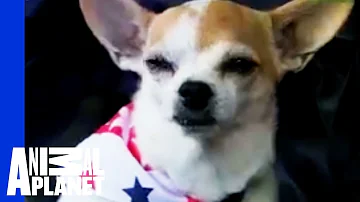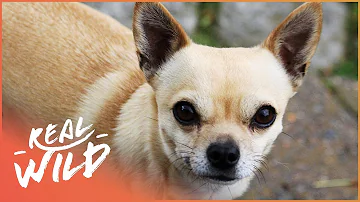
Chihuahua Dog
Canis lupus familiaris

Meet the Chihuahua Dog
The Chihuahua is the smallest recognized breed of dog, originating in the Mexican state of the same name. Known for their alertness, lively personality, and devotion to their owners, Chihuahuas are popular as companion animals worldwide. Despite their tiny stature, Chihuahuas are bold, confident, and often exhibit a 'big dog' attitude. They have a variety of coat colors and can have either smooth or long hair. These dogs thrive best in indoor environments and form strong bonds with their families.
Classification
Mammal
Habitat
Domestic (primarily indoor, human dwellings)
Diet
Omnivore
Lifespan
12-20 years
Conservation
Domesticated
Weight
1.5–3 kg (3–6.5 lbs)
📖Fascinating Facts
Tiny but Mighty
Chihuahuas are known for their fearless temperament and often behave as if they are much larger than their actual size.
Royal Heritage
The breed is thought to have ancient roots, potentially descending from companion dogs kept by the Toltec civilization.
Urban Adaptability
Chihuahuas adapt extremely well to apartment living and require relatively little space or outdoor exercise compared to larger breeds.
📋Detailed Description
The Chihuahua is a diminutive breed of domestic dog, typically weighing between 1.5 to 3 kg (3.3 to 6.6 lbs) and standing 15 to 23 cm (6 to 9 inches) at the shoulder. Despite their small size, Chihuahuas possess a well-proportioned, compact body with a characteristic 'apple-shaped' skull and large, expressive eyes. Their ears are notably large and upright, aiding in acute auditory perception. The breed is divided into two coat types: smooth (short-haired) and long-haired, both of which come in a wide spectrum of colors and patterns. Chihuahuas are known for their high energy, alertness, and intelligence, often forming intense attachments to a single person or family unit. Socially, they can be wary of strangers and other animals, sometimes displaying territorial or protective behaviors disproportionate to their size. Their vocalizations are frequent and serve as a warning system, reflecting their origins as alert companion animals. Reproductively, Chihuahuas have small litters, typically 2–5 puppies, and require attentive care due to their size and potential for birthing complications. Their longevity is notable, with an average lifespan of 12–20 years, making them one of the longest-lived dog breeds. Anatomically, their small size is the result of selective breeding, and they retain a number of neotenic (juvenile) features, such as a relatively large head and prominent eyes, which contribute to their appeal as companion animals.
💡 Did you know?
Chihuahuas have the largest brain-to-body size ratio of any dog breed.
🔬Research & Sources
🎭Behavior & Social Structure
Chihuahuas are highly alert and responsive, often serving as effective watchdogs despite their size. They exhibit strong loyalty to their primary caregivers and may develop separation anxiety if left alone for extended periods. Their daily routines typically involve bursts of energetic play interspersed with periods of rest. Chihuahuas are intelligent and can be trained to perform a variety of tasks, though they may display stubbornness or independence. Socialization is crucial, as poorly socialized individuals may become overly timid or aggressive. Feeding behavior is opportunistic; while omnivorous, they thrive on high-quality, protein-rich diets formulated for small breeds. Unlike larger dogs, Chihuahuas are less likely to engage in hunting behaviors, but they may chase small prey such as insects or rodents. They communicate through a range of vocalizations, body postures, and facial expressions, and often use barking to alert their owners to perceived threats.
👶Reproduction & Life Cycle
Chihuahuas reach sexual maturity between 6 and 12 months of age. The breed is known for its relatively small litter sizes, averaging 2–5 puppies per pregnancy. The gestation period is approximately 63 days. Due to their diminutive stature and relatively large head size of the puppies, Chihuahuas are at increased risk for dystocia (difficult labor), and cesarean sections are not uncommon in breeding programs. Females exhibit typical canine estrous cycles, with two heat periods per year. Parental care is primarily provided by the mother, who nurses and grooms the puppies for the first 6–8 weeks. Early socialization and handling are important for proper behavioral development. Responsible breeding practices are essential to avoid hereditary health issues such as hydrocephalus, patellar luxation, and heart defects.
🛡️Adaptations & Survival
Chihuahuas have evolved several adaptations to thrive as companion animals in human environments. Their small size is a result of artificial selection, allowing them to live comfortably in confined indoor spaces. Their large, upright ears enhance their ability to detect sounds, making them effective alert dogs. The breed's high metabolism supports their energetic nature but also necessitates frequent, small meals. Their expressive eyes and facial features facilitate communication with humans, reinforcing their role as social companions. Behaviorally, Chihuahuas are adaptable and can adjust to various living conditions, though they are sensitive to cold temperatures due to their small body mass and often require protective clothing in cooler climates.
📚Research Sources
🎨Cultural Significance
The Chihuahua holds a prominent place in Mexican culture, often associated with the ancient Techichi dogs kept by the Toltec civilization. While the direct lineage is debated, Chihuahuas are considered a symbol of Mexican heritage and pride. In modern times, they have become global icons, frequently featured in media, advertising, and as celebrity pets. Their image is often used to represent spunk and tenacity, and they have appeared in folklore as mystical or protective animals. The breed's popularity surged in the late 20th and early 21st centuries, further cementing its role as a beloved companion and cultural symbol.
🔬Recent Research & Discoveries
Recent genetic studies have explored the origins of the Chihuahua, suggesting a complex ancestry involving both ancient Mexican dogs and European toy breeds. Mitochondrial DNA analysis indicates that while some genetic material traces back to pre-Columbian dogs, there is significant admixture from European breeds introduced after the Spanish conquest. Ongoing research focuses on the health impacts of extreme miniaturization, with studies examining the prevalence and management of congenital disorders. Behavioral research highlights the importance of early socialization in preventing fear-based aggression. Advances in veterinary care have improved outcomes for common health issues, and there is increasing emphasis on responsible breeding to maintain genetic diversity.
🎥Wildlife Videos

The Chihuahua and the Chicken (Full Episode) | Unlikely Animal Friends
This episode of Unlikely Animal Friends features heartwarming stories of unbreakable bonds formed between two animals of a ...
Nat Geo Animals

Wildlife - Just Wild Dogs | Free Documentary Nature
Wildlife - Episode 7: Just Wild Dogs | Wildlife Documentary Watch 'Wildlife - Episode 8' here: https://youtu.be/kglJpB4ei8o Run ...
Free Documentary - Nature

The Unique Adaptations of Chihuahuas | BarkFest
About Barkfest: Welcome to the world of wildlife rehabilitation, a profession that appeals only to those with a strong will and a big ...
Nat Geo Animals

Chihuahua | Dogs 101
More on the Chihuahua: http://animal.discovery.com/breed-selector/dog-breeds/toy/chihuahua.html#mkcpgn=ytapl1 Find Your ...
Animal Planet

Man's First Friend - The Epic Story of Dogs & Humans | Free Documentary Nature
Man's First Friend - Ths History of Dogs & Humans | Nature Documentary Watch 'Wildlife - Just Wild Dogs' here: ...
Free Documentary - Nature

Tiny Chihuahua, Big Attitude! | The Love Of Dogs | Real Wild Documentary
Comedian and dog-lover, Paul O'Grady, brings his affectionate, funny presenting style to a show that explores the unbreakable ...
Real Wild
🌍Habitat Information
The Chihuahua Dog typically inhabits Domestic (primarily indoor, human dwellings) environments. Chihuahua Dogs have adapted to their environments with specialized features and behaviors.
Primary Habitat:
Domestic (primarily indoor, human dwellings)
More detailed habitat information will be available soon.
🛡️Conservation Status
The Chihuahua Dog is currently classified as Domesticated. Conservation efforts are crucial for preserving this species for future generations.
Common Threats:
- 🏠Habitat loss and fragmentation
- 🌡️Climate change impacts
- 🎯Hunting and poaching
- 🏭Human-wildlife conflict
⚠️Threats & Conservation Challenges
As a domesticated breed, Chihuahuas do not face natural predation or habitat loss, but they are susceptible to a range of health challenges. These include genetic disorders such as hydrocephalus, heart disease, patellar luxation, and dental problems due to their small jaws. Overbreeding and irresponsible breeding practices can exacerbate these issues. Chihuahuas are also at risk of injury from falls or rough handling due to their fragile skeletal structure. Obesity is a growing concern, as overfeeding and lack of exercise can lead to metabolic and orthopedic problems. While not threatened in terms of population, ethical breeding and proper care remain ongoing challenges for the breed's welfare.
🔬Scientific Classification
Scientific Name
Canis lupus familiaris
Classification Hierarchy
🔍 About Taxonomic Classification
Taxonomic classification is a hierarchical system used by scientists to classify and organize living organisms based on shared characteristics and evolutionary relationships.
The system moves from broad categories (Kingdom) to increasingly specific ones, with each animal's scientific name typically consisting of its Genus and species.
📝Community Notes
Share your observations and insights about the Chihuahua Dog with our community of wildlife enthusiasts.
Join Our Community
Sign in to share your observations and connect with fellow wildlife enthusiasts.
Sign In to ContributeNo community notes yet
Be the first to share your observations about the Chihuahua Dog!
Explore Chihuahua Dog
Select a tab above to learn more about this amazing animal.
📸Photo Gallery
No photos available for this animal yet.
🌟Discover More Wildlife
Continue your journey of discovery with more fascinating animals from our database
